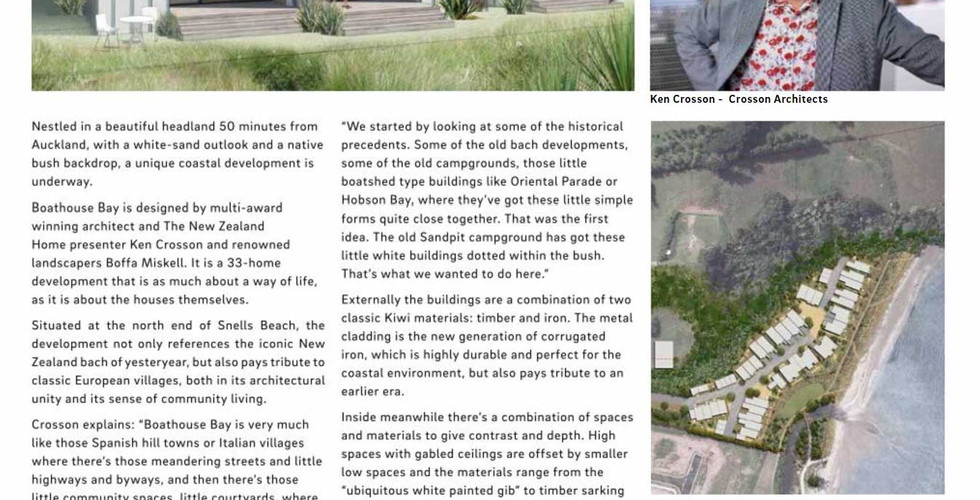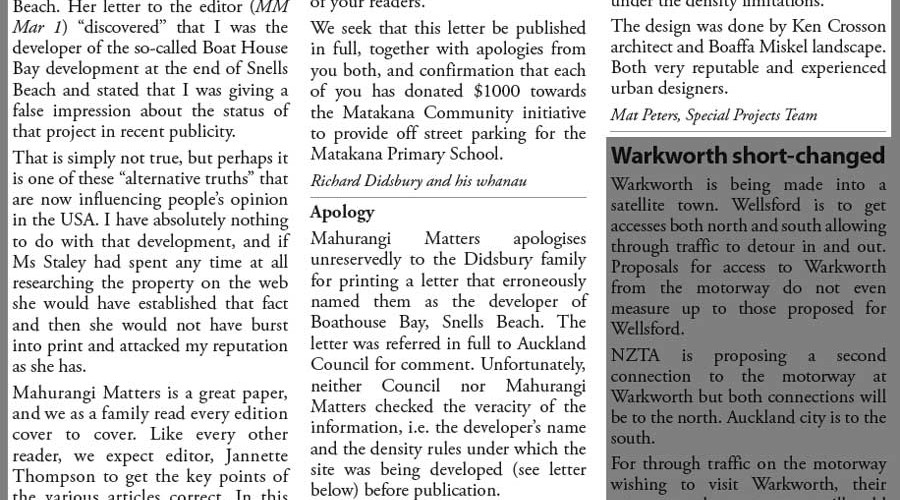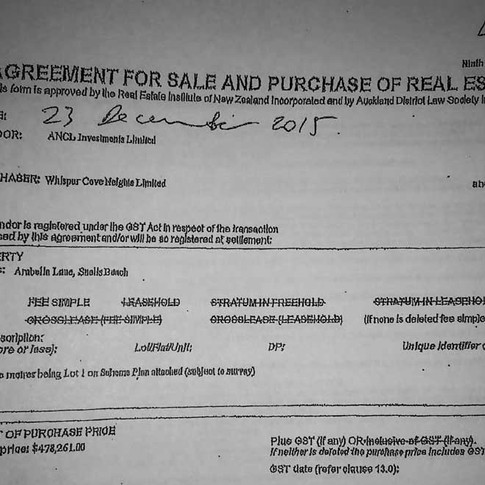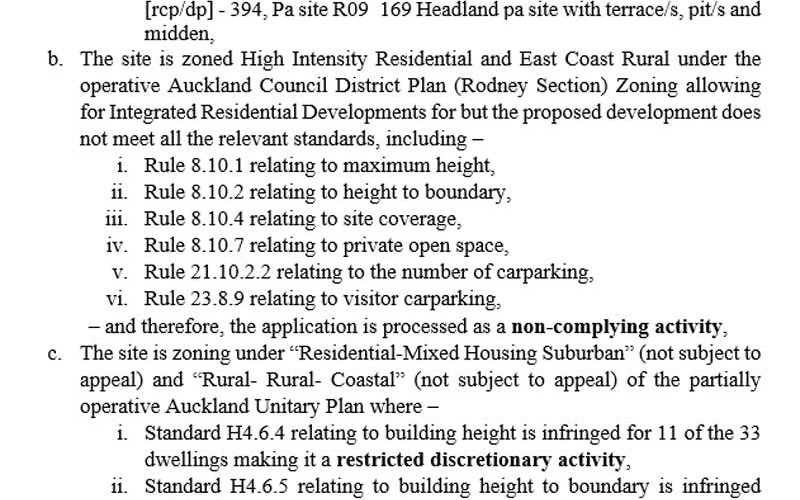FACT CHECK: Did Didsbury bury his complicity in Boathouse Bay?
- Grant McLachlan

- Sep 28, 2017
- 10 min read
Updated: Feb 3, 2025
If you view this year’s 1 March issue of Mahurangi Matters, one thing stands out. Can you spot it?

That blank space on page 4 was a letter to the editor by a concerned local that was removed at the insistence of a nationally-prominent property developer, Richard Didsbury. This guy:

Why you ask? What dastardly thing could the letter have said?
What started as an innocent letter to the editor raising legitimate concerns about the transparency of council processes was swiftly deflected with claims of defamation.
Comparing what was published to what evidence has been leaked to me, I have to ask: Was the Mahurangi Matters on the receiving end of a classic snow job?
Here is the Oxford Dictionary definition of the term:

'False Facts'
The original redacted letter was the first part in a series of coordinated deceptions. Here is the original letter that was published:
Richard Didsbury has a pretty sound reputation for his high-quality developments that are sympathetic to their surroundings. Imagine my shock and disappointment to discover what he has planned for the northern end of Snells Beach.
He’s called it Boathouse Bay and it crams 33 tent-like baches into a site that would only allow 2 dwellings under the operative Rodney District Plan and new Auckland Unitary Plan.
The publicity for the development, however, gives the false impression that it has all the necessary resource and building consents. When we contacted the council planners they were very elusive, said that they didn’t know about the development, but then agreed they might be processing an application.
There are many outstanding appeals for aspects of the Auckland Unitary Plan that specifically relates to this very sensitive site. Any resource consent application should be publicly notified as I am sure that not only the application but also the Unitary Plan needs the robust scrutiny of a public hearing.
Jacquie Staley, Snells Beach
OK, the letter seems pretty innocence enough. A member of the public raised concerns about a proposed development giving the false impression of being 'underway' without building or resource consents, insisting that any resource consent application be publicly notified. The letter was in response to the following feature in January's Junction Magazine:
The following issue of Mahurangi Matters, on 15 March 2017, contained not one but three letters rebutting Jacqui Staley's letter. Check it out:
(click on the image to enlarge or click here to visit the link.)
Wow! That's pretty serious! How dare Jacquie Staley write such lies! The outrage! The community shouldn't stand for such damning things to be written about such an honest and upstanding member.
Turns out, another concerned local did have something to say in the 12 April 2017 issue of Mahurangi Matters:
Neville Johnson. Where have I heard that name before?

Here's hoping that Jacquie Staley and Mahurangi Matters front up with $2000 so Neville Johnson's group can build their 'community' carpark, right?
Wrong. Not a cent changed hands it turns out. How come?
True facts
Instead of the public debate being about a proposed development being publicly notified, debate was shut down by Richard Didsbury's 'false facts' claims and that he had "absolutely nothing to do with that development."
While that spat fumed, the Boathouse Bay development obtained resource consent on 25 July 2017 without the application being notified. Turns out, their claims in January that the development was 'underway' and would be 'entering the market in Summer 2017' would turn out to be right.
There's just one problem. Well, that's not quite right. There are several problems...
Richard Didsbury's letter
In an email titled 'Defamation', Richard Didsbury's original letter to the editor of 'Matakana Matters' said:
Central to Richard Didsbury's rebuttal of Jacquie Staley's letter is his claim that he is not the 'developer' of Boathouse Bay. If you look again at Staley's letter, she doesn't make that claim at all. That was Didsbury's word - a ball that the editor of Mahurangi Matters and Mat Peters has picked up and run with.
Using the term 'developer' as the launching pad for his further attacks on Staley, he made the further claim, “I have absolutely nothing to do with that development."
OK, let's test that claim.
The resource consent application for Boathouse Bay was lodged on 23 December 2015 by Vavasour Investments Limited.

On the same day, Richard Didsbury signed a sale and purchase agreement to buy two of the lots from the landowner of the development, ANCL Investments Limited. Here are the covering pages for each of the lots:
As part of the resource consent application for Boathouse Bay, it states the following:

1-13 Hampton Mews is part of one of Didsbury's neighbouring developments, known as Whisper Cove. The only privately owned lot neighbouring the Boathouse Bay site not associated with Didsbury's interests is 15 Hampton Mews. That lot is the most directly affected by the proposed development.
Didsbury's written approval was, however, used by the developers to prevent 15 Hampton Mews from being notified, which also removes their rights to objection or appeal.
The Boathouse Bay site was the subject of previous resource consent applications by other developers. Those developments were withdrawn after the council planners threatened to publicly notify them. The developments provided for 2 and 16 building sites. Boathouse Bay's 33 dwellings, however, was approved without public notification.
So, what in Didsbury's written approval could be so convincing to prevent the application from being publicly notified? See for yourself:

That's right, the written approval wasn't included in the original application, nor has the written approval been disclosed after several requests.
So, why wasn't Mahurangi Matters and Auckland Council aware of Didsbury's purchase of the two lots? This clause of the contract might have something to do with it:

That confidentiality clause only applies to Lot 2. Why would Didsbury want to keep that a secret?
It turns out that the prices paid for the lots are much lower than two previous offers from other interested parties. Didsbury has since sold Lot 2 at a significant profit.
Why the original discount, you ask? Check out this clause:

But wait, there's more. Didsbury also convinced the landowner to surrender an easement right through the middle of Didsbury's neighbouring development, known as Whisper Cove Heights:

So, Didsbury is in the resource consent application, is on the scheme plan, and has a financial interest in the development going ahead. Anything else?

So, Didsbury is a developer with the owners of the Boathouse Bay site? Did I read that right?
The 'Developer's' letter
The letter from Mat Peters was unchallenged or verified by Mahurangi Matters. A simple Google search of Mat Peters would have revealed this gem from a National Business Review article in 14 July 2009:

Owing $39m to a finance company and $4.7m to the IRD is a big deal. Being bankrupted is even worse.
Using that information as a base, a simple search of the Companies Office database would have revealed the following:
That Mat Peters is a shareholder of Special Projects Team Limited;
That Mat Peters is a director and shareholder of Snells GP Limited; and
Snells GP Limited is the only partner of 59 Arabella Lane Limited Partnership.
But in the letter to Mahurangi Matters, is starts:
I can confirm that Richard Didsbury is not the developer of Boathouse Bay. The developer is 59 Arabella Lane Partnership.
In other words, Mat Peters wrote a letter to the Mahurangi Matters giving the impression that someone else was the developer when, in fact, he was the developer.
Staley's issue was never about who the developer was. Her issue was about the resource consent application.
The resource consent application was lodged by Vavasour Investments Limited. The directors of that company are Peter Martin and Ian Jason Gray. Martin is also the director and shareholder of Snells GP Limited. Gray is also the sole director and shareholder of ANCL Investments Limited. ANCL owns the land of the site of the development.
Confused? That's the point. Why wouldn't Mat Peters want it revealed that he is the developer?
Adjacent to the development is another development that went into receivership in June 2008 during construction of the so-called Whisper Cove. There was a risk that the council would be left with the task of collecting money from purchasers. Didsbury subsequently bought some of the Whisper Cove development adjacent to the Boathouse Bay site.
Mat Peters goes on to say:
The design was done by Ken Crosson architect and Boaffa [sic] Miskel [sic] landscape [sic]. Both are reputable and experienced urban designers.
Mat Peters appears to be trading on the reputations of others rather than his own. The developers had agreements with:
Didsbury to “consent to and support” the resource consent application, relying on Didsbury to gain consent;
Ken Crosson to design and promote the development and assist with gaining resource consent; and
Boffa Miskell to design and promote the development and assist with gaining resource consent.
Considering the history of development in the vicinity of the proposed development and the reputation of Peters, the editor should have fact-checked Mat Peters’ letter, which should have led to the disclosure of Peters’ involvement.
The reputation of the developers is more important than those who design a development or assists with gaining resource consent. The endorsements of people in contractual agreements is hardly impartial.
Imagine if Boathouse Bay went bust, owing money to purchasers, contractors, and the council. How many people could claim to have been misled by the information that was disclosed? How important is the information that hasn't been forthcoming? Would council officials, contractors, and purchasers have made the same decisions?
The rest of Mat Peters' letter muddies the waters further, although titling his letter 'Zoning clarification':
Zoning clarification
...The zoning under the Rodney District Plan was Residential High Intensity, which enabled up to 40 unit density. The Unitary Plan zone is Mixed Housing Suburban. For this site there is not [sic] density limit, only building controls.
In both zones, the development is under density limitations.
The statements about zoning are incorrect and contradictory. In one sentence, he says that there are no density limits and in a following he says there are. Also, the high intensity and mixed housing are not permitted activities as of right but require resource consent.
The application is, in fact, a non-complying activity due to the development not complying with a long list of criteria. Want a list? Here is a compilation:
Mat Peters claims that the site can "enable" up to 40 units. The resource consent application does not demonstrate how the site can “enable” up to 40 units. The proposal of 33 dwellings doesn’t meet many open space, yard, carparking, or height to boundary criteria.
The developer claims that, under the Unitary Plan, the site has no density limit, only building controls. This claim is simply wrong. Any dwelling is a discretionary activity that requires resource consent. That makes the permitted baseline, according to s104(2) of the Act, a “density limit” of zero.
Accordingly, the claim that “In both zones, the development is under density limitations” is not only inaccurate but misleading.
But, just a minute, Staley said in her letter that the site "would only allow 2 dwellings under the operative Rodney District Plan and new Auckland Unitary Plan." There are already 2 dwellings/building sites on the site. They are existing activities. Staley is correct.
Remember, the editor of Mahurangi Matters accepted the letter from Mat Peters as fact and refused to publish any letters challenging it.
The Editor's letter
"Mahurangi Matters apologises unreservedly to the Didsbury family for printing a letter that erroneously named him as the developer of Boathouse Bay."
Staley didn't name Didsbury as the developer of Boathouse Bay. Staley was shocked and disappointed to discover what Didsbury had planned for the northern end of Snells Beach. Didsbury was core to the plans of Boathouse Bay.
The letter was referred in full to Auckland Council for comment. Unfortunately, neither Council nor Mahurangi Matters checked the veracity of the information, i.e. the developer’s name and the density rules under which the site was being developed (see letter below) before publication.
The information in Ms Staley’s letter was correct. Admitting that the facts weren’t checked is not Ms Staley’s problem.
Referring the letter to the Council for comment and the Council not checking the facts is also not Ms Staley’s problem. These statements give the false impression that Ms Staley’s letter was incorrect.
That's not the full picture. The editor's letter to Staley gave another impression:
Instead of publishing the facts from an impartial source, the editor allowed a letter from the “developer” without checking the veracity of the information. The editor then published a letter from Neville Johnson defending Mahurangi Matters and Didsbury but attacking Staley.
Snow job?
The letter from Jacquie Staley contained facts that can be verified. The letters from Richard Didsbury and Mat Peters misdirected Staley's letter and reinforced their attacks with lies.
Didsbury claimed he was defamed. Neville Johnson claimed that the "false information" was "an unfair attack on his reputation and integrity." They are both wrong.
The basis of Staley's claims were truth. Also, Didsbury claims to be offended by something he has endorsed and profited from. Staley's allegations, however, do not meet the “minimum threshold of serious” as they cannot cause a serious degree of harm to Didsbury’s reputation (CPA Australia v NZICA [2015] NZHC 1854).
The editor of Mahurangi Matters has told me in writing that she was "bullied" by Didsbury to publish his letter. Mahurangi Matters went further by refusing to publish any letters defending Staley, even a letter from Staley herself. Didsbury "wouldn't allow it." The editor also refuses to publish a correction clarifying the facts surrounding Boathouse Bay and Didsbury's involvement.
The Press Council won't make a ruling as it considers the Didsbury letter outside the one month complaints period. It is purely up to Mahurangi Matters to do the right thing.
Basically, Didsbury snowjobbed Mahurangi Matters. Didsbury's actions also fulfilled his contractual obligations to the developers of Boathouse Bay. Boathouse Bay got consent without being publicly notified.
We are now finding out why they didn't want it notified. Here's a taste. And another. And the council is not making matters any better.
By the way, the 'community carpark' in Matakana that Didsbury demanded a donation to provides for the overflow parking from the Matakana Farmer's Market and Matakana Cinemas, which Didsbury developed. It also provides overflow parking for the Matakana School that Neville Johnson used to principal.
Looking back at Didsbury's letter, who was acting more like Donald Trump?
For more information on Boathouse Bay, visit their website or contact Colliers on 0800 966 315 to ask for an 'exclusive invite' to their VIP event on Monday 30 October at Brick Bay's Glasshouse. Guess who owns that venue?
We have our invite. See you there.




















